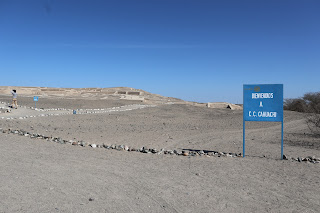Cahuachi, in Peru, was a major ceremonial center of the Nazca culture, based from 1 CE to about 500 CE in the coastal area of the Central Andes. It overlooked some of the Nazca lines.
The site contains over 40 mounds topped with adobe structures. The huge architectural complex covers 1.5 sq. km (0.6 sq. miles) at 365 m (1197.5 ft) above sea level.
Cahuachi's architecture and its organization are characteristic of a ceremonial center, and is not urban.
At Cahuachi, there are mound and room constructions, a structure called the “Great Temple”, walls that form corridors and passageways, as well as major walls, circular depressions, cylindrical shafts on top of mounds, and kanchas. Kanchas are the bounded open spaces beneath and between mounds and can be defined as a walled field or patio area that does not necessarily insinuate any specific function.
|
Entrance to Cahuachi |
|
Cahuachi Pyramids Plan
|
|
East group (Plan No. 1) |
|
Panorama of the east group (Plan No. 1) |
|
Panorama of the southern group (Plan No. 2) |
|
Panorama of the west group (Plan No. 3) |
|
Panorama of the Great Pyramid (Plan No. 5) |
|
Panorama from the north side (Plan No. 9)
|
|
Panorama of the Grand Square (Plan No. 4) |
|
Orange Pyramid (Plan No. 6) |
|
Panorama of the Orange Pyramid (Plan No. 6) and the west group (Plan
No. 3). |
|
Stepped Temple (Plan No. 7) |
|
Panorama of the Stepped Temple (Plan No. 7) |
|
Panorama of the Stepped Temple wall with Chakana pattern (Plan No.
8). |
|
Chakana pattern
|
|
Panorama of the east (left, Plan No. 1), south (center, Plan No. 2)
and west (right, Plan No. 3) groups. |
See also
Source
Location













































































